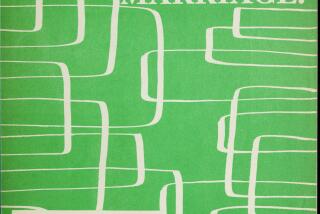Unexpected Applause for Premiere
- Share via
They made an extraordinary success of Elle, which AdWeek called “the most enthusiastically welcomed French contribution to America since the Statue of Liberty,” but when Murdoch Magazines and Hachette Publications last year announced their second joint venture, Premiere, the reaction of just about everybody was “so what?” Movie magazines had never been very successful, the gossip angle was well covered by People and Us, and serious students of cinema could rely on American Film and Film Comment.
The publishers were not worried, however, said Didier Guerin, who heads up the French company’s American operation. “Premiere is very popular in France,” he explained. “There is a new audience of people who love the movies. We knew that a serious, editorially balanced, non-intellectual magazine would do very well here too.”
“In fact,” added Joseph Cece, director of magazine development for Murdoch Magazines, “we’re doing better than expected.”
Although the circulation base is being held at 250,000, the $1.95 New York-based magazine is selling more than 300,000 copies. A direct mail campaign of nearly 2 million pieces in December produced a 5% return.
Premiere’s editor, Susan Lyne, formerly an editor at the Village Voice, believes the magazine’s timing was right. “When The Movies (a similar publication that appeared briefly in 1983) came out, the industry was making pictures for kids. Since then, independent film makers have demonstrated there is an audience for adult movies. And the home video market has helped create a new and older audience for serious films.”
Cece attributed Premiere’s success to its art direction, calling it one of the most “visually striking” magazines on the marketplace. In the wide-page format of European magazines, it uses color photographs and illustrations on nearly every page.
Although it avoids gossip--a profile of Robert Redford in the current issue concentrates on his roles as actor and director--Premiere has “a lighter touch” than its rivals, according to Lyne. “We have a sense of humor about movies. We don’t approach film with a reverential attitude.”
The March issue, its seventh, includes mini-profiles of the infant stars of “Baby Boom,” “Three Men and a Baby,” “Raising Arizona,” and “For Keeps.” A list preserves the expletives deleted from “Blue Velvet” for television. A chart compares the cost in New York of tickets, Twizzlers, Milk Duds, Coke and popcorn to the prices in places like Anchorage, Alaska; Missoula, Mont., and Macon, Ga.
What most distinguishes Premiere from other film magazines, however, is its serious and well-written approach to the business side of movie making. “The ‘80s are the decade when the businessman became a star,” Lyne said. “People are fascinated by money, by stories about the transfer of money, the making of money. And Hollywood is the most glamorous industry of all. Where else can you make one picture and become a millionaire overnight?”
The March issue, for example, includes a story on how Vestron grew from a video company to a movie studio, a short profile on North Carolina studio owner Earl Owensby, an expose of studio campaigns to influence the Oscars and a report on a typical press junket. The cover story on Harrison Ford is paired with a survey of the career of Roman Polanski, the director of Ford’s latest movie, “Frantic,” since leaving Hollywood a decade ago.
Actually, Premiere will begin a gossip column in the May issue, but it will cover insider news, such as who’s getting the best table at the commissary rather than whose baby Michael J. Fox is really having.
U.: A Great Idea
One of the best ideas for a new periodical we’ve seen is called U. and subtitled The National College Newspaper. In such categories as News (“40% of students polled admit cheating”), Opinions (“God plays campaign manager to no man”), Life and Art (“Tama Janowitz can’t be all bad, can she?”) and Student Body (“Sacrificing health for thinness”), U. reprints articles from college newspapers. Appearing monthly during the academic year, the journal is a nearly full-sized tabloid with color printed on stock like that used for the advertising inserts in Sunday’s newspaper.
According to Sheena Paterson-Berwick, who was associate editor at the Los Angeles Herald-Examiner before becoming publisher of the Santa Monica-based U., the periodical was developed in the course of three years of market studies, dummy issues and research.
“We put together a team of editors who are recent college graduates or still in school,” she said. They read submissions from 240 college newspapers from around the country, looking for news stories, features and reviews, hoping to spot trends that can be combined into special sections.
U. was the brainchild of Al Ehringer, a Santa Monica businessman with no previous publishing experience. He noticed in talking to his children that there was no national publication “where kids can share their ideas and discuss the issues that concern them.” The magazine has its offices on Main Street, the trendy Santa Monica shopping district behind which Ehringer is a moving force.
Supplement to College Press
U. attempts to supplement the college press, not supplant it. The magazine’s attractive use of color throughout its 24 pages was intended to provide an alternative for national advertisers to the school papers’ almost exclusive use of black-and-white. On most of the 215 campuses where U.’s 1.4-million copies are distributed, it is included as an insert in the college paper. For parents, recent graduates, journalism faculty and students on campuses where U. is not given away, U. offers an annual subscription for $12. (U. The National College Newspaper, 3110 Main St., Santa Monica 90405).
Edmund Sullivan, who runs the Columbia Scholastic Press Assn. at Columbia University, says he is impressed with the quality and the variety of the writing in U. “Students are very interested in what other students are doing,” he said. “It’s very important to break out of the parochial way of thinking you can get into on one campus. U. really is the best of college journalism.”
U.’s commitment to college journalism is expressed in its recently established fellowship program.
More to Read
The biggest entertainment stories
Get our big stories about Hollywood, film, television, music, arts, culture and more right in your inbox as soon as they publish.
You may occasionally receive promotional content from the Los Angeles Times.










